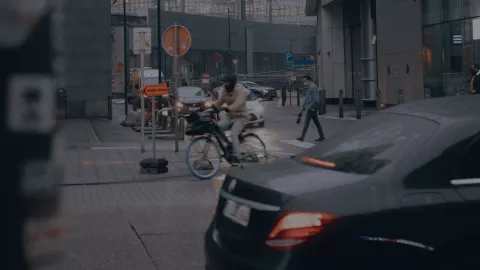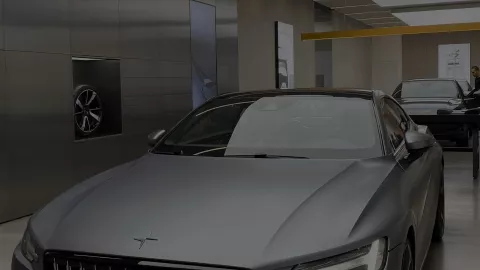The history of these two forms of transport is intertwined. First, roads were made for bicycles, as were the moves made to improve the pavements: only then did the automobile appear. The automobile developed from the bike, and not from the cart. “The first automobile was a three-wheeled bicycle, the Patent-Motorwagen invented by Carl Benz using parts from Germany's largest bicycle shop. Even the crucial parts of Henry Ford's “Quadricycle“ came from the bicycle,” recalls Bernardo Campos Pereira, an architect and specialist in the field of urban mobility. It was also the bicycle that paved the way for a transformation of public space with a view to a certain independence in mobility: one of the first Portuguese leisure maps, showing roads and railways, was produced in 1905 by the Portuguese Cycling Union. Tellingly, the Portuguese Automobile Club (ACP) produced its first road map in 1913.
Users of the new private and individual modes of transport were the people who lobbied for the creation of public infrastructure on which the bicycle and then the car could travel.
If bikes and their users were the first to use the network of good roads, the car began to impose itself over time in urban spaces. The human scale disappears, both in the short time that it takes to travel dozens of kilometers by private transport, and in the space occupied by the roads — and this new machine.
“At a certain point, our way of seeing roads changed. The United States was the first country to introduce road crossings, rules for crossing the road, and playgrounds to get children off the streets so they could play in safely segregated areas. The vision we have of the public space itself has changed, and has been conditioned to give priority to the automobile.” Bernardo Campos Pereira, architect and expert in urban mobility planning and policies.
This transition was initially prepared at the start of the 20th century. In cities like New York, the automobile’s appeal was easy to understand. This was the vehicle that promised to solve all the problems caused by horse-drawn carts: the smells and pollution, noise, congestion, and accidents. Ironically, these are consequences that large cities with lots of car traffic currently have to cope with, and added to this problem is the greater risk of traffic accidents caused by the high speeds cars travel at.
As we move towards a future of electric mobility, it’s time to rethink the way mobility has been shaped thus far. In urban environments during the 20th century, the phenomenon of traveling took on an increasingly individualized form, and the car was the lord and master of this transformation. However, there is one mode of individual transport that was forgotten during the second part of the 20th century: the bicycle.

At a certain point, our way of seeing roads changed. The United States was the first country to introduce road crossings, rules for crossing the road, and playgrounds to get children off the streets so they could play in safely segregated areas. The vision we have of the public space itself has changed, and has been conditioned to give priority to the automobile.”
Bernardo Campos Pereira, Architect and Expert in urban mobility planning and policies.
While a map of the country’s roads was published, mainly for cyclists, in Portugal in 1905, in the United States there were more accidents, with a growing number of deaths and injuries caused by cars in cities, so much so that they became part of the city's daily routine and stopped making the headlines.
"The replacement of the car by the electric car will only solve the problem of local pollution: it is not going to solve all the other externalities,” Bernardo Campos Pereira claims. The takeover of the public space by cars began all over the world at the beginning of the 20th century, when electric cares appeared on the market.
In Philadelphia in 1894 there was even an electric vehicle taxi service, the Electrobat, However, the sale of internal combustion engine-powered cars and electric vehicles competed strongly, and over time electric vehicles gained a bad reputation in the US, where they were viewed as cars for women.
During the first decade of the 20th century, manufacturers accepted this association and focused on women, who were not yet emancipated and represented a much smaller market. The projects for low-cost and commercially-viable electric cars were therefore being slowly abandoned — as was the case with the partnership between Henry Ford and Thomas Edison. The gasoline-powered car emerged victorious and shaped the North American and European landscape.
“During the 20th century, the automobile took over cities all over the world. It began to dictate the rules of occupation of public spaces and of municipal budgets: between 1920 and 1930, there was a big change in the United States — one that had been brewing since the early twentieth century. The concept of the sidewalk began to appear, as did pedestrian crosswalks in certain locations. There are photographs of the Largo do Rato in Lisbon in 1904, in which children can be seen playing marbles. Nowadays, the Largo do Rato is a transit zone without the life of its own that it could have had, given its position in the center,” notes Bernardo Campos Pereira.
By the 1930s, the bicycle had been democratized in the big cities and began its decline in Europe and the United States; lagging behind other western countries, in Portugal it remained the preferred means of transport in rural and industrial areas until around 1960. The commute to Porto, Viana do Castelo, and Lisbon, and their respective industrial zones was made by each day by workers on bicycles. In the rural central coastal areas, the Algarve, and the Alentejo, bikes were an essential means of transport for traveling longer distances during the mid-20th century.
“The car begins taking over the country’s financial and economic elites. In Portugal, the stigmaof the bike’s association with poverty is created. This happened a little earlier in other countries during the post-war period,” says Bernardo Campos Pereira, remembering that the link between bicycle use and the poor is still very real in countries like Mexico, where the poor population is called the pueblo bicicletero.
The oil crisis of the 1970s forced Europe to begin putting all its focus on the internal combustion engine and its dependence on this means of transport intoperspective. This led to a great revival in the use of bicycles in the heart of Western Europe. In the Netherlands, freeways close at the weekend to allow families to go for a walk or ride their bikes — while there has also been an emergence of civic movements, such as “Stop de Kindermoord” (Stop Killing Children), among other movements throughout Western Europe and North America concerned with heritage and environmental protection.
Following the 1974 revolution in Portugal, the country was moving in the opposite direction: “As of April 25, there was the concept of emancipation where people think they have the right to automobiles. 1974 and 1975 were the years with the greatest increase in car use, and the highest number of road accidents in Portugal. The industry itself changed the advertising, which used to be quite elitist, to become about a form of mobility for the people,” says Bernardo Campos Pires, noting that families continue to invest in cars to this day. It is only recently — within the last five years — that can we talk about the resumption of cycling in Portugal, thanks to the public policies introduced in some cities, such as Lisbon, particularly between 2015/16 and 2021, that have created the conditions in the city for bicycles.
What happens with cycling in cities around the world today is the same phenomenon that happened with the car during the 20th century: induced demand, i.e. new roads create more traffic. When we have traffic, we invest more in infrastructure. As they say in English: “Build it and they will come”. How many cars crossed the Tagus River between Alcântara and Almada before the 25 de Abril Bridge was built?
The major investment in the central European road networks was made through the post-war Marshall Plan, and for Bernardo Campos Pereira the accession of Portugal and Spain to the EEC resulted in the application of a metamorphosis of the Marshall Plan, this time using European instead of American funds — something that was more recently reimplemented in the countries ofEastern Europe.
The railroad did not develop as much in the two Iberian nations during this time; although there was a great deal of investment in high-speed rail in Spain, the regional railroad suffered greatly. Meanwhile, Spanish cities such as Barcelona, Pamplona, Pontevedra, San Sebastián, Valladolid, Vitoria and Valencia have managed to move toward more pedestrian paths and giving the bicycle an important role (including through cyclelogistics), thanks to a strong civil society that is close to local and regional governance. Nonetheless, investment in road infrastructure was also so “massive that it only stopped with the bailout of 2011.”
“In the Portugal Country Report that followed the bailout, the OECD issued a warning about Portugal’s “oversized road infrastructure”, noting that the country has economic, environmental, health, and social problems resulting from the excessive use of cars, especially in the big cities. In part, it was a bailout caused by dependence on the car and the unsustainable road infrastructure it requires. Polis programs include expensive parking facilities: each parking lot costs between 10,000 and 20,000 euros per parking space. This is public money that is used to finance the automobile because the car culture will not work without public funding and subsidies. Roads and parking lots are necessary. The car is a highly subsidized vehicle,” adds Bernardo Campos Pereira.
The present time is about defining what mobility is going to be like in the coming years, particularly in developed countries. Far from disappearing, the internal combustion engine-powered car is getting ready to be replaced by the electric car, and is searching for its place — increasingly removed from such urban centers as Paris, Barcelona, Milan and Amsterdam.
It is in rural areas and city centers that the bicycle is most widely used on this continent. The European figures are indicative of the recovery of cycling and green spaces in cities, to the detriment of asphalt.
"The replacement of the car by the electric car will only solve the problem of local pollution: it is not going to solve all the other externalities,” Bernardo Campos Pereira claims. The takeover of the public space by cars began all over the world at the beginning of the 20th century, when electric cares appeared on the market.
In Philadelphia in 1894 there was even an electric vehicle taxi service, the Electrobat, However, the sale of internal combustion engine-powered cars and electric vehicles competed strongly, and over time electric vehicles gained a bad reputation in the US, where they were viewed as cars for women.
During the first decade of the 20th century, manufacturers accepted this association and focused on women, who were not yet emancipated and represented a much smaller market. The projects for low-cost and commercially-viable electric cars were therefore being slowly abandoned — as was the case with the partnership between Henry Ford and Thomas Edison. The gasoline-powered car emerged victorious and shaped the North American and European landscape.
“During the 20th century, the automobile took over cities all over the world. It began to dictate the rules of occupation of public spaces and of municipal budgets: between 1920 and 1930, there was a big change in the United States — one that had been brewing since the early twentieth century. The concept of the sidewalk began to appear, as did pedestrian crosswalks in certain locations. There are photographs of the Largo do Rato in Lisbon in 1904, in which children can be seen playing marbles. Nowadays, the Largo do Rato is a transit zone without the life of its own that it could have had, given its position in the center,” notes Bernardo Campos Pereira.
By the 1930s, the bicycle had been democratized in the big cities and began its decline in Europe and the United States; lagging behind other western countries, in Portugal it remained the preferred means of transport in rural and industrial areas until around 1960. The commute to Porto, Viana do Castelo, and Lisbon, and their respective industrial zones was made by each day by workers on bicycles. In the rural central coastal areas, the Algarve, and the Alentejo, bikes were an essential means of transport for traveling longer distances during the mid-20th century.
“The car begins taking over the country’s financial and economic elites. In Portugal, the stigmaof the bike’s association with poverty is created. This happened a little earlier in other countries during the post-war period,” says Bernardo Campos Pereira, remembering that the link between bicycle use and the poor is still very real in countries like Mexico, where the poor population is called the pueblo bicicletero.
The oil crisis of the 1970s forced Europe to begin putting all its focus on the internal combustion engine and its dependence on this means of transport intoperspective. This led to a great revival in the use of bicycles in the heart of Western Europe. In the Netherlands, freeways close at the weekend to allow families to go for a walk or ride their bikes — while there has also been an emergence of civic movements, such as “Stop de Kindermoord” (Stop Killing Children), among other movements throughout Western Europe and North America concerned with heritage and environmental protection.
Following the 1974 revolution in Portugal, the country was moving in the opposite direction: “As of April 25, there was the concept of emancipation where people think they have the right to automobiles. 1974 and 1975 were the years with the greatest increase in car use, and the highest number of road accidents in Portugal. The industry itself changed the advertising, which used to be quite elitist, to become about a form of mobility for the people,” says Bernardo Campos Pires, noting that families continue to invest in cars to this day. It is only recently — within the last five years — that can we talk about the resumption of cycling in Portugal, thanks to the public policies introduced in some cities, such as Lisbon, particularly between 2015/16 and 2021, that have created the conditions in the city for bicycles.
What happens with cycling in cities around the world today is the same phenomenon that happened with the car during the 20th century: induced demand, i.e. new roads create more traffic. When we have traffic, we invest more in infrastructure. As they say in English: “Build it and they will come”. How many cars crossed the Tagus River between Alcântara and Almada before the 25 de Abril Bridge was built?
The major investment in the central European road networks was made through the post-war Marshall Plan, and for Bernardo Campos Pereira the accession of Portugal and Spain to the EEC resulted in the application of a metamorphosis of the Marshall Plan, this time using European instead of American funds — something that was more recently reimplemented in the countries ofEastern Europe.
The railroad did not develop as much in the two Iberian nations during this time; although there was a great deal of investment in high-speed rail in Spain, the regional railroad suffered greatly. Meanwhile, Spanish cities such as Barcelona, Pamplona, Pontevedra, San Sebastián, Valladolid, Vitoria and Valencia have managed to move toward more pedestrian paths and giving the bicycle an important role (including through cyclelogistics), thanks to a strong civil society that is close to local and regional governance. Nonetheless, investment in road infrastructure was also so “massive that it only stopped with the bailout of 2011.”
“In the Portugal Country Report that followed the bailout, the OECD issued a warning about Portugal’s “oversized road infrastructure”, noting that the country has economic, environmental, health, and social problems resulting from the excessive use of cars, especially in the big cities. In part, it was a bailout caused by dependence on the car and the unsustainable road infrastructure it requires. Polis programs include expensive parking facilities: each parking lot costs between 10,000 and 20,000 euros per parking space. This is public money that is used to finance the automobile because the car culture will not work without public funding and subsidies. Roads and parking lots are necessary. The car is a highly subsidized vehicle,” adds Bernardo Campos Pereira.
The present time is about defining what mobility is going to be like in the coming years, particularly in developed countries. Far from disappearing, the internal combustion engine-powered car is getting ready to be replaced by the electric car, and is searching for its place — increasingly removed from such urban centers as Paris, Barcelona, Milan and Amsterdam.
It is in rural areas and city centers that the bicycle is most widely used on this continent. The European figures are indicative of the recovery of cycling and green spaces in cities, to the detriment of asphalt.
O carro e a bicicleta uma relação histórica com futuro
1800
1810
1820
1830
1840
1850
1860
1870
1880
1890
1900
1910
1920
1930
1940
1950
1960
1970
1980
1990

